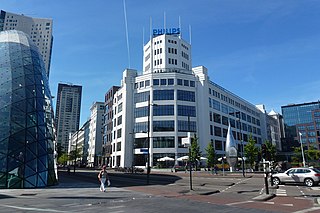
New Zealand is divided into sixteen regions for local government purposes. Eleven are administered by regional councils, and five are administered by unitary authorities, which are territorial authorities that also perform the functions of regional councils. The Chatham Islands Council is not a region but is similar to a unitary authority, authorised under its own legislation.

Greater Manchester is a metropolitan county and combined authority area in North West England, with a population of 2.8 million; comprising ten metropolitan boroughs: Manchester, Salford, Bolton, Bury, Oldham, Rochdale, Stockport, Tameside, Trafford and Wigan. The county was created on 1 April 1974, as a result of the Local Government Act 1972, and designated a functional city region on 1 April 2011. Greater Manchester is formed of parts of the historic counties of Cheshire, Lancashire and the West Riding of Yorkshire.

The regional chambers of England were a group of indirectly elected regional bodies that were created by the provisions of the Regional Development Agencies Act 1998. There were eight regional chambers, one for each of the regions of England except Greater London, which had opted for an elected mayor and assembly in 1998. All eight regional chambers had adopted the title "regional assembly" or "assembly" as part of their name, though this was not an official status in law. The chambers were abolished over a two-year period between 31 March 2008 and 31 March 2010 and some of their functions were assumed by newly established Local authority leaders' boards.

The Porto Metropolitan Area is a metropolitan area in northern Portugal centered on the City of Porto, Portugal's second largest city. The metropolitan area, covering 17 municipalities, is the second largest urban area in the country and one of the largest in the European Union, with a population in 2011 of 1,721,038 in an area of 2,040.31 km².

The Association of Greater Manchester Authorities (AGMA) is the local government association for Greater Manchester, a metropolitan county in North West England. It was established in 1986 as a voluntary organisation to represent the ten district councils of Greater Manchester after the Greater Manchester County Council was abolished. AGMA develops policy, lobbies government and others, and runs a range of services designed to make strategic and tangible advances in the standard of living across Greater Manchester. Its Policy and Research Unit is based in Wigan,
The Northwest Regional Development Agency (NWDA) was the regional development agency for the North West England region and was a non-departmental public body. It was abolished on 31 March 2012.
The Greater Manchester City Region, commonly just the Manchester City Region and sometimes the Greater Manchester Statutory City Region, is a combined authority region in England, consisting of Greater Manchester and five boroughs, roughly the historic county of Lancashire's eastern parts. It is under the strategic governance of the Greater Manchester Combined Authority, officially designated on 1 April 2011 and has a population of 3,363,555 according to figures from the office for national statistics (2011)

A metropolis is a large city or conurbation which is a significant economic, political, and cultural center for a country or region, and an important hub for regional or international connections, commerce, and communications.

The Métropole du Grand Paris, or Greater Paris, is a métropole covering the City of Paris and its nearest surrounding suburbs. The métropole came into existence on 1 January 2016; it comprises 131 communes, including Paris and all 123 communes in the surrounding inner-suburban departments of the Petite Couronne, plus seven communes in two of the outer-suburban departments, including the communes of Argenteuil in Val-d'Oise, Savigny-sur-Orge, Juvisy-sur-Orge, Viry-Châtillon and Paray-Vieille-Poste in Essonne, the last of which covers part of Orly Airport. Part of the métropole comprises the Seine department, which existed from 1929 to 1968. Grand Paris covers 814 square kilometers and has a population of over 7 million.

The regions, formerly known as the government office regions, are the highest tier of sub-national division in England, established in 1994. Between 1994 and 2011, nine regions had officially devolved functions within government. While they no longer fulfil this role, they continue to be used for statistical and some administrative purposes. While the UK was a member of the European Union, they defined areas (constituencies) for the purposes of elections to the European Parliament. Eurostat also used them to demarcate first level Nomenclature of Territorial Units for Statistics (NUTS) regions within the European Union, which in 2021 were superseded by International Territorial Level (ITL) regions. The regions generally follow the boundaries of the former standard regions, established in the 1940s for statistical purposes.

The Leeds City Region is a local enterprise partnership city region located in West Yorkshire, England. Prior to the West Yorkshire devolution deal, the partnership covered parts of South and North Yorkshire. According to the Office for National Statistics, as of 2017 the city region ranked 2nd behind Greater London for both population and GVA in the United Kingdom. It has a population of 2,320,214 million and a GVA of £69.62 billion.

A combined authority is a type of local government institution introduced in England outside Greater London by the Local Democracy, Economic Development and Construction Act 2009. Combined authorities are created voluntarily and allow a group of local authorities to pool appropriate responsibility and receive certain delegated functions from central government in order to deliver transport and economic policy more effectively over a wider area.

The Greater Manchester Combined Authority (GMCA) is a combined authority for Greater Manchester, England. It was established on 1 April 2011 and consists of 11 members; 10 indirectly elected members, each a directly elected councillor from one of the ten metropolitan boroughs that comprise Greater Manchester together with the directly elected Mayor of Greater Manchester. The authority derives most of its powers from the Local Government Act 2000 and Local Democracy, Economic Development and Construction Act 2009, and replaced a range of single-purpose joint boards and quangos to provide a formal administrative authority for Greater Manchester for the first time since the abolition of the Greater Manchester County Council in 1986.
In England, local enterprise partnerships (LEPs) are voluntary partnerships between local authorities and businesses, set up in 2011 by the Department for Business, Innovation and Skills to help determine local economic priorities and lead economic growth and job creation within the local area. They carry out some of the functions previously carried out by the regional development agencies which were abolished in March 2012. In certain areas, funding is received from the UK government via growth deals.

The Metropoolregio Eindhoven, until 1 January 2014 the Samenwerkingsverband Regio Eindhoven is a regional governmental agency for the city region of Eindhoven, Netherlands. The MRE comprises 21 municipalities in the Eindhoven agglomeration, with a total area of 1,457.81 square kilometers. The region has nearly three quarters of a million inhabitants and some 35.000 companies.
A secondary city often follows after a primate city and can be seen in the urban hierarchy. Secondary cities often have between “500,000 to 3 million inhabitants, but are frequently unknown outside of their national or regional context. Many secondary cities in the Global South are expected to undergo massive expansions in the next few decades, comparable to city growth in Europe and North America over the past two centuries.

Greg Clark, an urbanist, is an author, global advisor, chairman and non-executive director. Clark has advised more than 300 cities, 50 national governments and a wide array of bodies including the OECD, Brookings Institution, the World Bank and the Urban Land Institute (ULI) on strategies for city development and investment. He also advises global investors and corporate service companies on how to align with city leaders.
The Metro Manila Dream Plan, formally titled the Roadmap for Transport Infrastructure Development for Metro Manila and Its Surrounding Areas, refers to a 2014 integrated plan for improving the transport system in Metro Manila, Philippines, with the hope of turning it into a focal point for addressing Metro Manila's interlinked problems in the areas of transportation, land use, and environment.

The Mayor of Greater Manchester is the directly elected metro mayor of Greater Manchester, responsible for strategic governance in the region that includes health, transport, housing, strategic planning, waste management, policing, the Greater Manchester Fire and Rescue Service and skills. The creation of the Mayor of Greater Manchester was agreed between the then Chancellor of the Exchequer, George Osborne, and Greater Manchester's 10 district council leaders. As well as having specific powers, the mayor chairs the Greater Manchester Combined Authority, also assuming the powers of the Greater Manchester Police and Crime Commissioner.

The Mayor of West Yorkshire is a directly elected mayor responsible for the metropolitan county of West Yorkshire in England. The Mayor chairs and leads the West Yorkshire Combined Authority, and assumes the office and powers of the West Yorkshire Police and Crime Commissioner.












